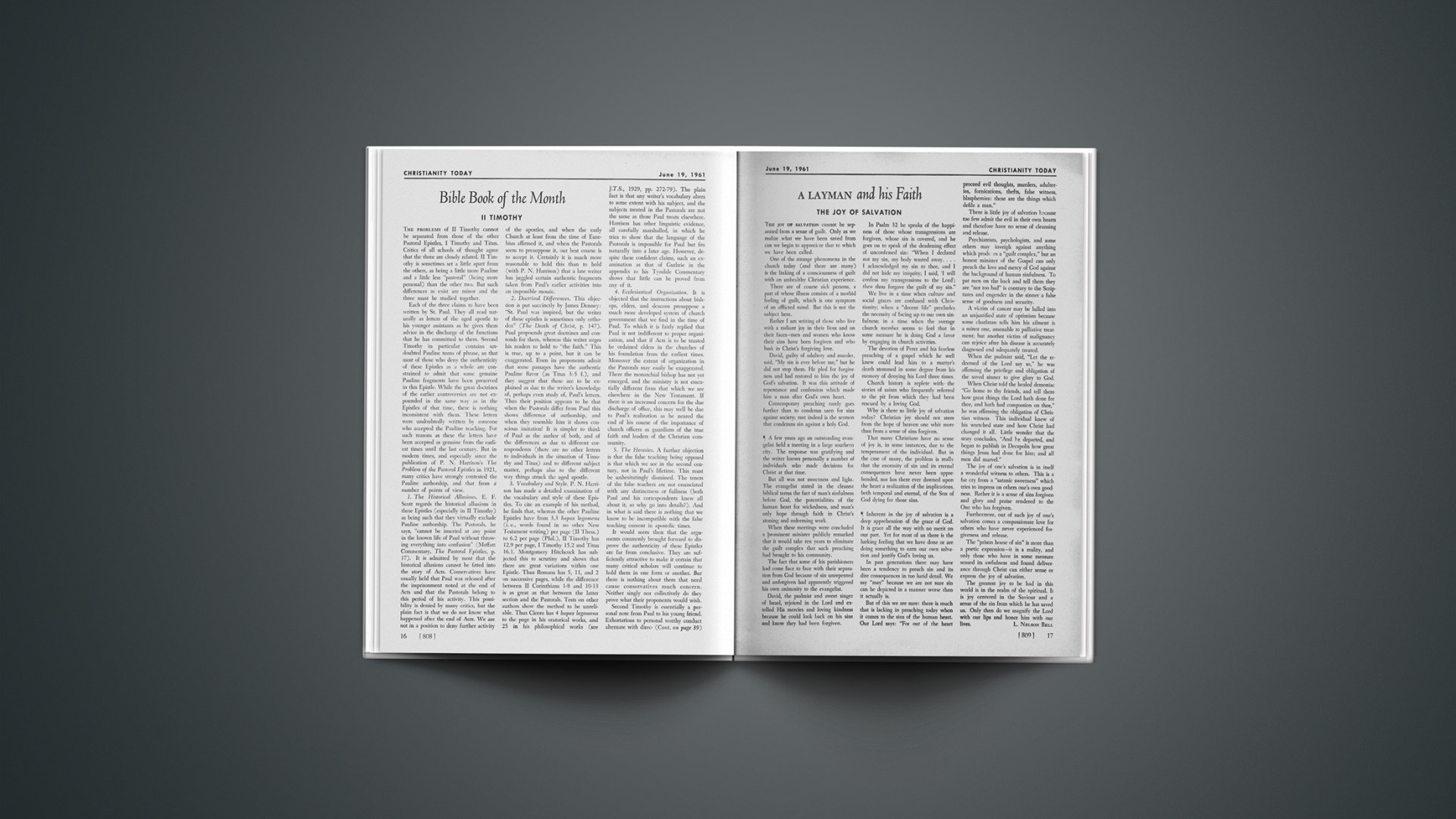The problems of II Timothy cannot be separated from those of the other Pastoral Epistles, I Timothy and Titus. Critics of all schools of thought agree that the three are closely related. II Timothy is sometimes set a little apart from the others, as being a little more Pauline and a little less “pastoral” (being more personal) than the other two. But such differences as exist are minor and the three must be studied together.
Each of the three claims to have been written by St. Paul. They all read naturally as letters of the aged apostle to his younger assistants as he gives them advice in the discharge of the functions that he has committed to them. Second Timothy in particular contains undoubted Pauline turns of phrase, so that most of those who deny the authenticity of these Epistles as a whole are constrained to admit that some genuine Pauline fragments have been preserved in this Epistle. While the great doctrines of the earlier controversies are not expounded in the same way as in the Epistles of that time, there is nothing inconsistent with them. These letters were undoubtedly written by someone who accepted the Pauline teaching. For such reasons as these the letters have been accepted as genuine from the earliest times until the last century. But in modern times, and especially since the publication of P. N. Harrison’s The Problem of the Pastoral Epistles in 1921, many critics have strongly contested the Pauline authorship, and that from a number of points of view.
1. The Historical Allusions. E. F. Scott regards the historical allusions in these Epistles (especially in II Timothy) as being such that they virtually exclude Pauline authorship. The Pastorals, he says, “cannot be inserted at any point in the known life of Paul without throwing everything into confusion” (Moffatt Commentary, The Pastoral Epistles, p. 17). It is admitted by most that the historical allusions cannot be fitted into the story of Acts. Conservatives have usually held that Paul was released after the imprisonment noted at the end of Acts and that the Pastorals belong to this period of his activity. This possibility is denied by many critics, but the plain fact is that we do not know what happened after the end of Acts. We are not in a position to deny further activity of the apostles, and when the early Church at least from the time of Eusebius affirmed it, and when the Pastorals seem to presuppose it, our best course is to accept it. Certainly it is much more reasonable to hold this than to hold (with P. N. Harrison) that a late writer has juggled certain authentic fragments taken from Paul’s earlier activities into an impossible mosaic.
2. Doctrinal Differences. This objection is put succinctly by James Denney: “St. Paul was inspired, but the writer of these epistles is sometimes only orthodox” (The Death of Christ, p. 147). Paul propounds great doctrines and contends for them, whereas this writer urges his readers to hold to “the faith.” This is true, up to a point, but it can be exaggerated. Even its proponents admit that some passages have the authentic Pauline flavor (as Titus 3:5 f.), and they suggest that these are to be explained as due to the writer’s knowledge of, perhaps even study of, Paul’s letters. Thus their position appears to be that when the Pastorals differ from Paul this shows difference of authorship, and when they resemble him it shows conscious imitation! It is simpler to think of Paul as the author of both, and of the differences as due to different correspondents (there are no other letters to individuals in the situation of Timothy and Titus) and to different subject matter, perhaps also to the different way things struck the aged apostle.
3. Vocabulary and Style. P. N. Harrison has made a detailed examination of the vocabulary and style of these Epistles. To cite an example of his method, he finds that, whereas the other Pauline Epistles have from 3.3 hapax legomena (i. e., words found in no other New Testament writing) per page (II Thess.) to 6.2 per page (Phil.), II Timothy has 12.9 per page, I Timothy 15.2 and Titus 16.1. Montgomery Hitchcock has subjected this to scrutiny and shows that there are great variations within one Epistle. Thus Romans has 5, 11, and 2 on successive pages, while the difference between 2 Corinthians 1–8 and 10–13 is as great as that between the latter section and the Pastorals. Tests on other authors show the method to be unreliable. Thus Cicero has 4 hapax legomena to the page in his oratorical works, and 25 in his philosophical works (see J.T.S., 1929, pp. 272–79). The plain fact is that any writer’s vocabulary alters to some extent with his subject, and the subjects treated in the Pastorals are not the same as those Paul treats elsewhere. Harrison has other linguistic evidence, all carefully marshalled, in which he tries to show that the language of the Pastorals is impossible for Paul but fits naturally into a later age. However, despite these confident claims, such an examination as that of Guthrie in the appendix to his Tyndale Commentary shows that little can be proved from any of it.
4. Ecclesiastical Organization. It is objected that the instructions about bishops, elders, and deacons presuppose a much more developed system of church government that we find in the time of Paul. To which it is fairly replied that Paul is not indifferent to proper organization, and that if Acts is to be trusted he ordained elders in the churches of his foundation from the earliest times. Moreover the extent of organization in the Pastorals may easily be exaggerated. There the monarchial bishop has not yet emerged, and the ministry is not essentially different from that which we see elsewhere in the New Testament. If there is an increased concern for the due discharge of office, this may well be due to Paul’s realization as he neared the end of his course of the importance of church officers as guardians of the true faith and leaders of the Christian community.
5. The Heresies. A further objection is that the false teaching being opposed is that which we see in the second century, not in Paul’s lifetime. This must be unhesitatingly dismissed. The tenets of the false teachers are not enunciated with any distinctness or fullness (both Paul and his correspondents knew all about it, so why go into details?). And in what is said there is nothing that we know to be incompatible with the false teaching current in apostolic times.
It would seem then that the arguments commonly brought forward to disprove the authenticity of these Epistles are far from conclusive. They are sufficiently attractive to make it certain that many critical scholars will continue to hold them in one form or another. But there is nothing about them that need cause conservatives much concern. Neither singly nor collectively do they prove what their proponents would wish.
Second Timothy is essentially a personal note from Paul to his young friend. Exhortations to personal worthy conduct alternate with directions to deal firmly with false teachers. It is difficult to divide the Epistle into hard and fast divisions. It is a true letter; the writer does not attempt to give a systematic treatment of his topics but drifts naturally from one to another and back again. After the opening salutation and thanksgiving (1:1–5) there is an exhortation to courageous testimony (1:6–14). Next comes some news from Paul (1:15–18), and then more exhortations, first to endurance (2:1–13) and then to right personal conduct (2:14–26). After this Paul turns his attention to the last days and speaks of the evil men who will arise at that time, and of the effects of their teaching (3:1–9). He turns then to the work of the ministry and reminds Timothy of the persecutions which are inevitable (3:10–13), and of the important place occupied by the Scriptures (3:14–17). Then he urges him to steadfastness in preaching and to the fulfillment of all that his ministry implies (4:1–5). As the letter comes to its close, Paul calmly contemplates his approaching end (4:6–8) and gives Timothy some instructions, especially urging him to come to him quickly (4:9–15). He speaks of the divine aid that has been afforded him (4:16–18), and the letter concludes with greetings and the grace (4:19–22).
This is a very moving document as we see the aged apostle facing death, looking back at his service for God, and taking tender concern for his son in the faith that he be strong in the task to which God has called him.
COMMENTARIES
Probably the most useful commentary for evangelicals is the Tyndale Commentary by Donald Guthrie (Tyndale Press, 1957). It has a helpful introduction and a useful examination of the Epistle. W. Hendriksen’s Commentary (Baker, 1957) is also very valuable. E. K. Simpson’s The Pastoral Epistles (Tyndale Press, 1954) is a good commentary on the Greek text and is enhanced by many references to classical authors. This book has a valuable bibliography compiled by F. F. Bruce for those who want further reading in this Epistle. The volume in the International Critical Commentary series is by W. Lock (T. & T. Clark, 1924), and is on the whole conservative. A good commentary from the point of view of a more advanced criticism is the Moffatt Commentary volume by E. F. Scott (Hodder & Stoughton, 1936). Another is B. S. Easton’s The Pastoral Epistles (Scribner’s, 1947). The most highly regarded discussion of the problems from the point of view of the modern critic is The Problem of the Pastoral Epistles, by P. N. Harrison (O. U. P., 1921). See also Harrison’s articles in The Expository Times, lxvii (1955, pp. 77–81), and New Testament Studies, ii (1956, pp. 250–61). Support is given to Harrison by K. Grayston and G. Herdan, New Testament Studies, vi (1959, pp. 1–15). But he is strongly opposed by others. In addition to the article by Montgomery Hitchcock mentioned above, B. M. Metzger’s article in The Expository Times, lxx (1958, pp. 91–94), should be consulted. Metzger shows that Harrison has not validated his method, and that many competent critical scholars disagree with him. E. Earle Ellis discusses the problem in Paul’s Use of the Old Testament (Oliver and Boyd, 1957, pp. 5–9), and again in an excellent article in The Evangelical Quarterly, xxxii (1960, pp. 151–61). This is perhaps the most convenient summary of the position.
LEON MORRIS
Vice-Principal
Ridley College
Melbourne, Australia










